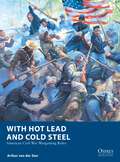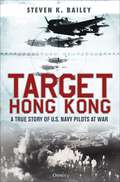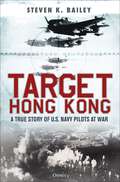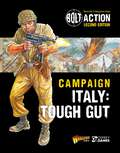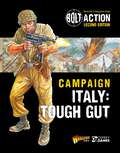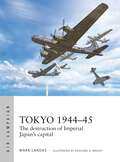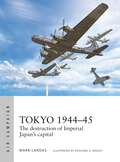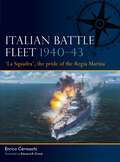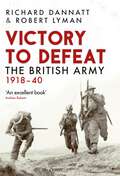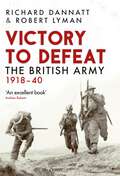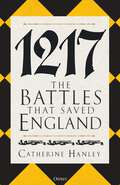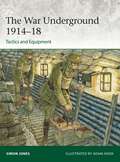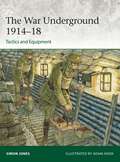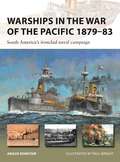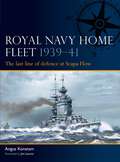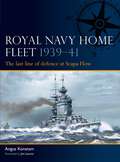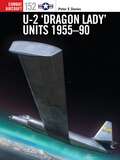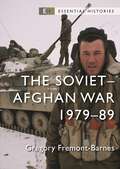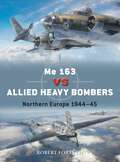- Table View
- List View
With Hot Lead and Cold Steel: American Civil War Wargaming Rules (Osprey Wargames #32)
by Arthur van SterA set of wargaming rules for fighting large battles set during the American Civil War.From the First Bull Run to Appomattox Court House, enter one of the defining conflicts of American history. With shot, shell, and sabre, guide the armies of the Blue and the Grey through this first modern war to determine the fate of a nation.With Hot Lead and Cold Steel is a large-scale, mass-battle wargame for recreating the American Civil War. Designed to handle brigade and divisional level engagements while providing a balance between ease of play and period detail, With Hot Lead and Cold Steel is ideal for new gamers and wargaming veterans alike. It contains everything players need to raise armies and craft scenarios, whether based upon historical campaigns and orders of battle or those of their own devising.
With Hot Lead and Cold Steel: American Civil War Wargaming Rules (Osprey Wargames #32)
by Arthur van SterA set of wargaming rules for fighting large battles set during the American Civil War.From the First Bull Run to Appomattox Court House, enter one of the defining conflicts of American history. With shot, shell, and sabre, guide the armies of the Blue and the Grey through this first modern war to determine the fate of a nation.With Hot Lead and Cold Steel is a large-scale, mass-battle wargame for recreating the American Civil War. Designed to handle brigade and divisional level engagements while providing a balance between ease of play and period detail, With Hot Lead and Cold Steel is ideal for new gamers and wargaming veterans alike. It contains everything players need to raise armies and craft scenarios, whether based upon historical campaigns and orders of battle or those of their own devising.
Target Hong Kong: A true story of U.S. Navy pilots at war
by Steven K. BaileyBrought to life by the personal accounts of six Navy pilots and one British POW, this is the history of the U.S. Navy airstrikes on Japanese-held Hong Kong.Commander John Lamade started the war in 1941 a nervous pilot of an antiquated biplane. Just over three years later he was in the cockpit of a cutting-edge Hellcat about to lead a strike force of 80 aircraft through the turbulent skies above the South China Sea. His target: Hong Kong. As a storm of antiaircraft fire darkened the sky, watching from below was POW Ray Jones. For three long years he and his fellow prisoners had endured near starvation conditions in a Japanese internment camp. Did these American aircraft, he wondered, herald freedom? Trawling through historic records, Steven K. Bailey discovered that the story of the U.S. Navy airstrikes on Japanese-held Hong Kong during the final year of World War II had never been told. Operation Gratitude involved nearly 100 U.S. Navy warships and close to a thousand planes. Target Hong Kong brings this massive operation down to a human scale by recounting the air raids through the experiences of seven men whose lives intersected at Hong Kong in January 1945: Commander John D. Lamade, five of his fellow U.S. Navy pilots and the POW Ray Jones. Drawing upon oral histories, diary transcripts, and U.S. Navy documents, this book expertly narrates the intertwined experiences of these servicemen to bring the history to life.
Target Hong Kong: A true story of U.S. Navy pilots at war
by Steven K. BaileyBrought to life by the personal accounts of six Navy pilots and one British POW, this is the history of the U.S. Navy airstrikes on Japanese-held Hong Kong.Commander John Lamade started the war in 1941 a nervous pilot of an antiquated biplane. Just over three years later he was in the cockpit of a cutting-edge Hellcat about to lead a strike force of 80 aircraft through the turbulent skies above the South China Sea. His target: Hong Kong. As a storm of antiaircraft fire darkened the sky, watching from below was POW Ray Jones. For three long years he and his fellow prisoners had endured near starvation conditions in a Japanese internment camp. Did these American aircraft, he wondered, herald freedom? Trawling through historic records, Steven K. Bailey discovered that the story of the U.S. Navy airstrikes on Japanese-held Hong Kong during the final year of World War II had never been told. Operation Gratitude involved nearly 100 U.S. Navy warships and close to a thousand planes. Target Hong Kong brings this massive operation down to a human scale by recounting the air raids through the experiences of seven men whose lives intersected at Hong Kong in January 1945: Commander John D. Lamade, five of his fellow U.S. Navy pilots and the POW Ray Jones. Drawing upon oral histories, diary transcripts, and U.S. Navy documents, this book expertly narrates the intertwined experiences of these servicemen to bring the history to life.
Bolt Action: Campaign: Italy: Tough Gut (Bolt Action)
by Warlord GamesA new supplement for Bolt Action focusing on the later Italian Campaign, following on from Soft Underbelly, adding new units, scenarios, and special rules.In Italy, the fight continues!As the Allies push north up the Italian Peninsula, they have encountered heavy resistance from the Axis and their multitude of fortified and defensive lines, slowing the allied advance to a crawl. The 'soft underbelly' of Europe proved to be false, instead it was a 'tough gut'. This supplement for Bolt Action, and the counterpart to Soft Underbelly, focuses on the battles ranging from the Gustav Line in 1944 all the way to those of the Gothic Line in 1945, with the breakouts at Anzio and Monte Cassino of particular focus. Containing a host of scenarios to refight these famous battles, along with new units, special rules, and Theatre Selectors, this book contains everything players need to bring an end to the war and liberate Italy.
Bolt Action: Campaign: Italy: Tough Gut (Bolt Action)
by Warlord GamesA new supplement for Bolt Action focusing on the later Italian Campaign, following on from Soft Underbelly, adding new units, scenarios, and special rules.In Italy, the fight continues!As the Allies push north up the Italian Peninsula, they have encountered heavy resistance from the Axis and their multitude of fortified and defensive lines, slowing the allied advance to a crawl. The 'soft underbelly' of Europe proved to be false, instead it was a 'tough gut'. This supplement for Bolt Action, and the counterpart to Soft Underbelly, focuses on the battles ranging from the Gustav Line in 1944 all the way to those of the Gothic Line in 1945, with the breakouts at Anzio and Monte Cassino of particular focus. Containing a host of scenarios to refight these famous battles, along with new units, special rules, and Theatre Selectors, this book contains everything players need to bring an end to the war and liberate Italy.
Tokyo 1944–45: The destruction of Imperial Japan's capital (Air Campaign #40)
by Mark LardasThe full history of how the United States targeted and destroyed the Japanese capital from the air, in a ten-month long campaign by the US Army Air Force and the US Navy.In November 1944, the US Army Air Force launched a 111-plane B-29 strike against Tokyo, the first raid since the morale-boosting Doolittle Raid of 1942. From then until August 13, 1945, the United States would attack Tokyo 25 times, 20 from B-29s based in the Marianas and five from US Navy carrier task forces. The campaign included the single deadliest air raid in human history, when around 100,000 people were killed by the firestorm created by the Operation Meetinghouse raid of March 10, 1945. This book, the first to examine the full history of the United States' air campaign against the greatest target in Japan, looks at the USAAF's and US Navy's efforts to use air power to eliminate Tokyo's strategic value to the Empire. It considers how the campaign developed from daylight bombing to firebombing and anti-ship mining, and finally how the target was handed over to the US Navy, whose carrier-based bombers and fighter-bombers continued to strike Tokyo during July and August 1945.Using specially commissioned battlescenes, strategic maps and diagrams, this volume presents a detailed picture of how Tokyo was vanquished from the air.
Tokyo 1944–45: The destruction of Imperial Japan's capital (Air Campaign #40)
by Mark LardasThe full history of how the United States targeted and destroyed the Japanese capital from the air, in a ten-month long campaign by the US Army Air Force and the US Navy.In November 1944, the US Army Air Force launched a 111-plane B-29 strike against Tokyo, the first raid since the morale-boosting Doolittle Raid of 1942. From then until August 13, 1945, the United States would attack Tokyo 25 times, 20 from B-29s based in the Marianas and five from US Navy carrier task forces. The campaign included the single deadliest air raid in human history, when around 100,000 people were killed by the firestorm created by the Operation Meetinghouse raid of March 10, 1945. This book, the first to examine the full history of the United States' air campaign against the greatest target in Japan, looks at the USAAF's and US Navy's efforts to use air power to eliminate Tokyo's strategic value to the Empire. It considers how the campaign developed from daylight bombing to firebombing and anti-ship mining, and finally how the target was handed over to the US Navy, whose carrier-based bombers and fighter-bombers continued to strike Tokyo during July and August 1945.Using specially commissioned battlescenes, strategic maps and diagrams, this volume presents a detailed picture of how Tokyo was vanquished from the air.
Italian Battle Fleet 1940–43: 'La Squadra', the pride of the Regia Marina (Fleet #6)
by Enrico CernuschiA comprehensive. illustrated account of the wartime Italian battle fleet, from its ships and technology to command structure, logistics, codebreaking and more.In the 1920s, the Italian Navy faced great challenges. Mussolini's ambitious Italy turned away from its alliance with Britain and France, and the Regia Marina faced the prospect of confronting both the French Navy and the Mediterranean Fleet of the Royal Navy. In the years leading up to World War II, the Regia Marina built and deployed a powerful battleship-led fleet – known in Italy as 'La Squadra' – intended to make the Mediterranean an Italian sea once more. In this book, Italian naval historian Enrico Cernuschi offers a fresh assessment of the wartime Italian battle fleet, based on his lifetime of primary-source research from both Italian and Allied sources. It offers a comprehensive portrait of this proud armada, how it was devised and built, and how it operated and fought. It covers a multitude of factors often overlooked, such as Italy's naval codebreakers, the fleet's logistics, and the qualities and limitations of Italian industry that supported it. The book also provides a concise account and analysis of the battle fleet's activities through the war, from major clashes such as the Battle of Calabria to lesser-known expeditions. The author's research into Italian wartime primary sources overturns some myths still commonplace in Anglo-American accounts. Illustrated with superb new artwork, maps and 3D diagrams, and featuring rare photos, this book is a fascinating account of Italy's great fleet of World War II.
Italian Battle Fleet 1940–43: 'La Squadra', the pride of the Regia Marina (Fleet #6)
by Enrico CernuschiA comprehensive. illustrated account of the wartime Italian battle fleet, from its ships and technology to command structure, logistics, codebreaking and more.In the 1920s, the Italian Navy faced great challenges. Mussolini's ambitious Italy turned away from its alliance with Britain and France, and the Regia Marina faced the prospect of confronting both the French Navy and the Mediterranean Fleet of the Royal Navy. In the years leading up to World War II, the Regia Marina built and deployed a powerful battleship-led fleet – known in Italy as 'La Squadra' – intended to make the Mediterranean an Italian sea once more. In this book, Italian naval historian Enrico Cernuschi offers a fresh assessment of the wartime Italian battle fleet, based on his lifetime of primary-source research from both Italian and Allied sources. It offers a comprehensive portrait of this proud armada, how it was devised and built, and how it operated and fought. It covers a multitude of factors often overlooked, such as Italy's naval codebreakers, the fleet's logistics, and the qualities and limitations of Italian industry that supported it. The book also provides a concise account and analysis of the battle fleet's activities through the war, from major clashes such as the Battle of Calabria to lesser-known expeditions. The author's research into Italian wartime primary sources overturns some myths still commonplace in Anglo-American accounts. Illustrated with superb new artwork, maps and 3D diagrams, and featuring rare photos, this book is a fascinating account of Italy's great fleet of World War II.
Victory to Defeat: The British Army 1918–40
by Richard Dannatt Robert LymanA compelling history of the decline of an army from the triumph of victory in 1918 to defeat in 1940 and why this happened. A salutary warning for modern Britain. The British Army won a convincing series of victories between 1916 and 1918. But by 1939 the British Army was an entirely different animal. The hard-won knowledge, experience and strategic vision that delivered victory after victory in the closing stages of the First World War had been lost. In the inter-war years there was plenty of talking, but very little focus on who Britain might have to fight, and how. Victory to Defeat clearly illustrates how the British Army wasn't prepared to fight a first-class European Army in 1939 for the simple reason that as a country Britain hadn't prepared itself to do so. The failure of the army's leadership led directly to its abysmal performance in Norway and France in 1940. Victory to Defeat is a captivating history of the mismanagement of a war-winning army. It is also a stark warning that we neglect to understand who our enemy might be, and how to defeat him, at the peril of our country. The British Army is now to be cut to its smallest size since 1714. Are we, this book asks, repeating the same mistakes again?
Victory to Defeat: The British Army 1918–40
by Richard Dannatt Robert LymanA compelling history of the decline of an army from the triumph of victory in 1918 to defeat in 1940 and why this happened. A salutary warning for modern Britain. The British Army won a convincing series of victories between 1916 and 1918. But by 1939 the British Army was an entirely different animal. The hard-won knowledge, experience and strategic vision that delivered victory after victory in the closing stages of the First World War had been lost. In the inter-war years there was plenty of talking, but very little focus on who Britain might have to fight, and how. Victory to Defeat clearly illustrates how the British Army wasn't prepared to fight a first-class European Army in 1939 for the simple reason that as a country Britain hadn't prepared itself to do so. The failure of the army's leadership led directly to its abysmal performance in Norway and France in 1940. Victory to Defeat is a captivating history of the mismanagement of a war-winning army. It is also a stark warning that we neglect to understand who our enemy might be, and how to defeat him, at the peril of our country. The British Army is now to be cut to its smallest size since 1714. Are we, this book asks, repeating the same mistakes again?
1217: The Battles that Saved England
by Dr Catherine HanleyAn engrossing history of the pivotal year 1217 when invading French forces were defeated and the future of England secured. In 1215 King John had agreed to the terms of Magna Carta, but he then reneged on his word, plunging the kingdom into war. The rebellious barons offered the throne to the French prince Louis and set off the chain of events that almost changed the course of English history. Louis first arrived in May 1216, was proclaimed king in the heart of London, and by the autumn had around half of England under his control. However, the choice of a French prince had enormous repercussions: now not merely an internal rebellion, but a war in which the defenders were battling to prevent a foreign takeover. John's death in October 1216 left the throne in the hands of his nine-year-old son, Henry, and his regent, William Marshal, which changed the face of the war again, for now the king trying to fight off an invader was not a hated tyrant but an innocent child.1217 charts the nascent sense of national identity that began to swell. Three key battles would determine England's destiny. The fortress of Dover was besieged, the city of Lincoln was attacked, and a great invasion force set sail and, unusually for the time, was intercepted at sea. Catherine Hanley expertly navigates medieval siege warfare, royal politics, and fighting at sea to bring this remarkable period of English history to life.
1217: The Battles that Saved England
by Dr Catherine HanleyAn engrossing history of the pivotal year 1217 when invading French forces were defeated and the future of England secured. In 1215 King John had agreed to the terms of Magna Carta, but he then reneged on his word, plunging the kingdom into war. The rebellious barons offered the throne to the French prince Louis and set off the chain of events that almost changed the course of English history. Louis first arrived in May 1216, was proclaimed king in the heart of London, and by the autumn had around half of England under his control. However, the choice of a French prince had enormous repercussions: now not merely an internal rebellion, but a war in which the defenders were battling to prevent a foreign takeover. John's death in October 1216 left the throne in the hands of his nine-year-old son, Henry, and his regent, William Marshal, which changed the face of the war again, for now the king trying to fight off an invader was not a hated tyrant but an innocent child.1217 charts the nascent sense of national identity that began to swell. Three key battles would determine England's destiny. The fortress of Dover was besieged, the city of Lincoln was attacked, and a great invasion force set sail and, unusually for the time, was intercepted at sea. Catherine Hanley expertly navigates medieval siege warfare, royal politics, and fighting at sea to bring this remarkable period of English history to life.
The War Underground 1914–18: Tactics and Equipment (Elite #256)
by Simon JonesThis absorbing illustrated study reveals the evolving tactics and techniques used by all sides in the underground war during 1914–18. Covering the Western Front but also the Gallipoli and Italian theatres, this study explores three aspects of World War I below ground: military mining, attack tunnels and dugouts. In 1914–17, the underground war was a product of static trench warfare, essential to survive it and part of both sides' attempts to overcome it. In 1917–18 it was rendered largely obsolete by the development of the all-arms battle as mobility was restored to the battlefield. In the stagnant, troglodyte existence of trench warfare, military mining was a hidden world of heroism and terror in which hours of suspenseful listening were spent monitoring the steady picking of unseen opponents, edging quietly towards the enemy, and judging when to fire a charge. Break-ins to enemy mine galleries resulted in hand-to-hand fighting in the darkness. The ingenuity, claustrophobia and tactical importance of the underground war are discussed and depicted in this fully illustrated study from an acknowledged expert. The artwork plates include depictions of the specialized uniforms, weapons and equipment used underground, as well as vignettes that vividly convey the many aspects of subterranean warfare during World War I.
The War Underground 1914–18: Tactics and Equipment (Elite #256)
by Simon JonesThis absorbing illustrated study reveals the evolving tactics and techniques used by all sides in the underground war during 1914–18. Covering the Western Front but also the Gallipoli and Italian theatres, this study explores three aspects of World War I below ground: military mining, attack tunnels and dugouts. In 1914–17, the underground war was a product of static trench warfare, essential to survive it and part of both sides' attempts to overcome it. In 1917–18 it was rendered largely obsolete by the development of the all-arms battle as mobility was restored to the battlefield. In the stagnant, troglodyte existence of trench warfare, military mining was a hidden world of heroism and terror in which hours of suspenseful listening were spent monitoring the steady picking of unseen opponents, edging quietly towards the enemy, and judging when to fire a charge. Break-ins to enemy mine galleries resulted in hand-to-hand fighting in the darkness. The ingenuity, claustrophobia and tactical importance of the underground war are discussed and depicted in this fully illustrated study from an acknowledged expert. The artwork plates include depictions of the specialized uniforms, weapons and equipment used underground, as well as vignettes that vividly convey the many aspects of subterranean warfare during World War I.
Warships in the War of the Pacific 1879–83: South America's ironclad naval campaign (New Vanguard #328)
by Angus KonstamSuperbly illustrated with original artwork throughout, this book explores the ironclad warships that fought the little-known battles of South America's War of the Pacific. In the late 19th century, a war erupted between Chile and Peru, the catalyst for which was control of guano-rich Chincha islands. Given the geography of the two countries, with a narrow, arid land border and long exposed coastlines, it was inevitable that the War of the Pacific would predominantly be a naval war. It was a unique episode of military history, fought by two newly emergent South American states, using the latest technology – ironclad, steam-powered warships – and involving more naval battles than in the American Civil War, including a blockade, the capture of key warships, and bombardments of ports. Chile's navy was larger and more modern, while Peru's trump card was the small but powerful ironclad Huáscar. In this book, naval expert Angus Konstam offers readers an essential guide to this little-known naval war, illustrated with detailed profiles of the key ironclads, spectacular original artwork of the battles and a cutaway of Huáscar. He briefly covers the strategies of the warring powers as well as exploring all the key points of the naval campaign and the details of the warships involved, as a handful of ironclads fought for naval supremacy in South America.
Warships in the War of the Pacific 1879–83: South America's ironclad naval campaign (New Vanguard #328)
by Angus KonstamSuperbly illustrated with original artwork throughout, this book explores the ironclad warships that fought the little-known battles of South America's War of the Pacific. In the late 19th century, a war erupted between Chile and Peru, the catalyst for which was control of guano-rich Chincha islands. Given the geography of the two countries, with a narrow, arid land border and long exposed coastlines, it was inevitable that the War of the Pacific would predominantly be a naval war. It was a unique episode of military history, fought by two newly emergent South American states, using the latest technology – ironclad, steam-powered warships – and involving more naval battles than in the American Civil War, including a blockade, the capture of key warships, and bombardments of ports. Chile's navy was larger and more modern, while Peru's trump card was the small but powerful ironclad Huáscar. In this book, naval expert Angus Konstam offers readers an essential guide to this little-known naval war, illustrated with detailed profiles of the key ironclads, spectacular original artwork of the battles and a cutaway of Huáscar. He briefly covers the strategies of the warring powers as well as exploring all the key points of the naval campaign and the details of the warships involved, as a handful of ironclads fought for naval supremacy in South America.
Royal Navy Home Fleet 1939–41: The last line of defence at Scapa Flow (Fleet #5)
by Angus KonstamPacked with illustrations, this is a new history and analysis of how the Royal Navy's most important fleet operated and fought the German Navy in the crucial first years of World War II.Throughout its history, the Royal Navy's most powerful fleet has been the one guarding home waters. In this book, naval historian Angus Konstam explores the fighting power, the roles, and the battles of the Home Fleet, in the crucial first years of World War II when it was Britain's most powerful fighting force, anchored in the northern bastion of Scapa Flow. He explains the complex responsibilities of the fleet, charged simultaneously with preventing the powerful German Navy from breaking out into the Atlantic; preparing to challenge any cross-Channel invasion force; and attacking German naval operations in the North Sea. Home Fleet actions included the loss of HMS Hood, the sinking of the Bismarck and countering the invasion of Norway, Germany's biggest amphibious operation of the war.Packed with striking new artwork and 3D diagrams and maps, this book offers a detailed portrait of the Home Fleet during these most crucial years of the war, from the capabilities of the warships to logistics and intelligence-gathering, to how the fleet was organized and commanded, and how and why it fought as it did.
Royal Navy Home Fleet 1939–41: The last line of defence at Scapa Flow (Fleet #5)
by Angus KonstamPacked with illustrations, this is a new history and analysis of how the Royal Navy's most important fleet operated and fought the German Navy in the crucial first years of World War II.Throughout its history, the Royal Navy's most powerful fleet has been the one guarding home waters. In this book, naval historian Angus Konstam explores the fighting power, the roles, and the battles of the Home Fleet, in the crucial first years of World War II when it was Britain's most powerful fighting force, anchored in the northern bastion of Scapa Flow. He explains the complex responsibilities of the fleet, charged simultaneously with preventing the powerful German Navy from breaking out into the Atlantic; preparing to challenge any cross-Channel invasion force; and attacking German naval operations in the North Sea. Home Fleet actions included the loss of HMS Hood, the sinking of the Bismarck and countering the invasion of Norway, Germany's biggest amphibious operation of the war.Packed with striking new artwork and 3D diagrams and maps, this book offers a detailed portrait of the Home Fleet during these most crucial years of the war, from the capabilities of the warships to logistics and intelligence-gathering, to how the fleet was organized and commanded, and how and why it fought as it did.
U-2 ‘Dragon Lady’ Units 1955–90 (Combat Aircraft #152)
by Peter E. DaviesAn illustrated account of the early service of the Lockheed U-2, one of the most important and longest-serving intelligence gathering platforms fielded by the US air force.The U-2 is one of the most recognizable aircraft of the Cold War; nicknamed the 'Dragon Lady' after the codename given to it by the CIA, this powered glider was designed and operated in great secrecy, providing US authorities with photographic and electronic information from areas of interest across the globe. This illuminating new volume dives deep into the U-2's most critical missions, exploring its role in the Cuban Missile Crisis, nuclear reconnaissance in the Soviet Union, and intelligence missions in China and North Vietnam.Using previously unpublished research, aviation expert Peter E. Davies examines the operations of one of the landmark aircraft of the 20th century from a fresh and engaging perspective, enhanced by more than 50 photos and 21 newly commissioned profile artworks.
U-2 ‘Dragon Lady’ Units 1955–90 (Combat Aircraft #152)
by Peter E. DaviesAn illustrated account of the early service of the Lockheed U-2, one of the most important and longest-serving intelligence gathering platforms fielded by the US air force.The U-2 is one of the most recognizable aircraft of the Cold War; nicknamed the 'Dragon Lady' after the codename given to it by the CIA, this powered glider was designed and operated in great secrecy, providing US authorities with photographic and electronic information from areas of interest across the globe. This illuminating new volume dives deep into the U-2's most critical missions, exploring its role in the Cuban Missile Crisis, nuclear reconnaissance in the Soviet Union, and intelligence missions in China and North Vietnam.Using previously unpublished research, aviation expert Peter E. Davies examines the operations of one of the landmark aircraft of the 20th century from a fresh and engaging perspective, enhanced by more than 50 photos and 21 newly commissioned profile artworks.
The Soviet–Afghan War: 1979–89 (Essential Histories)
by Gregory Fremont-BarnesA fully illustrated overview of the USSR's bloody conflict in Afghanistan and its long legacy.The Soviet invasion of its neighbour Afghanistan in December 1979 sparked a nine-year conflict until Soviet forces withdrew in 1988–89, dooming the communist Afghanistan government to defeat at the hands of the mujahideen, the Afghan popular resistance backed by the USA and other powers. Gregory Fremont-Barnes reveals how the Soviet invasion had enormous implications on the global stage; it prompted the US Senate to refuse to ratify the hard-won SALT II arms-limitation treaty, and the USA and 64 other countries boycotted the 1980 Moscow Summer Olympics. For Afghanistan, the invasion served to prolong the interminable civil war that pitted central government against the regions and faction against faction. Updated and revised for the new edition, with full-colour maps and new images throughout, this succinct account explains the origins, events and consequences of the Soviet intervention in Afghanistan, shedding new light on the more recent history – and prospects – of that troubled country.
The Soviet–Afghan War: 1979–89 (Essential Histories)
by Gregory Fremont-BarnesA fully illustrated overview of the USSR's bloody conflict in Afghanistan and its long legacy.The Soviet invasion of its neighbour Afghanistan in December 1979 sparked a nine-year conflict until Soviet forces withdrew in 1988–89, dooming the communist Afghanistan government to defeat at the hands of the mujahideen, the Afghan popular resistance backed by the USA and other powers. Gregory Fremont-Barnes reveals how the Soviet invasion had enormous implications on the global stage; it prompted the US Senate to refuse to ratify the hard-won SALT II arms-limitation treaty, and the USA and 64 other countries boycotted the 1980 Moscow Summer Olympics. For Afghanistan, the invasion served to prolong the interminable civil war that pitted central government against the regions and faction against faction. Updated and revised for the new edition, with full-colour maps and new images throughout, this succinct account explains the origins, events and consequences of the Soviet intervention in Afghanistan, shedding new light on the more recent history – and prospects – of that troubled country.
Me 163 vs Allied Heavy Bombers: Northern Europe 1944–45 (Duel #135)
by Robert ForsythAn illustrated account of the dramatic engagement between the Luftwaffe's Me 163 units and Allied bombers during the closing years of World War II.In the summer of 1944, US Army Air Force (USAAF) aircrews flying over the Third Reich reported observing small, high-speed 'batlike' aircraft flying close to their formations. The Luftwaffe's extraordinary Messerschmitt Me 163 rocket-powered interceptor was making its devastating debut with Jagdgeschwader (JG) 400. Capable of reaching high altitudes in the shortest possible time by using a volatile rocket fuel, the Me 163 was the Luftwaffe's most impressive yet dangerous aircraft, and the fastest in the world. Luftwaffe expert Robert Forsyth details the testing of the aircraft and its lethal SG 500 'Fighter Fist' weapons system, as well as its deployment against the B17s and B24s of the USAAF's Eighth Air Force and, from late 1944, the Lancasters and Halifaxes of RAF Bomber Command. These duels started a deadly form of warfare, with the bomber squadrons striking at Germany's synthetic oil refineries and jet airfields, and the Me 163s of JG 400 trying to stop them using cutting-edge aeronautical technology.Using specially commissioned artwork, original photographs and rare first-hand interviews with the pilots that fought the decisive dogfights, this exciting book describes the pivotal encounters over Northern Europe.
